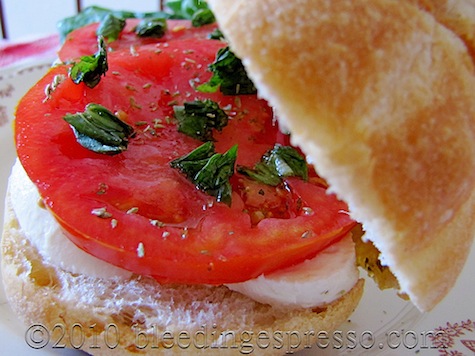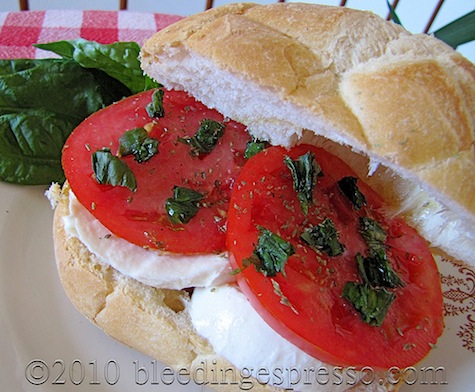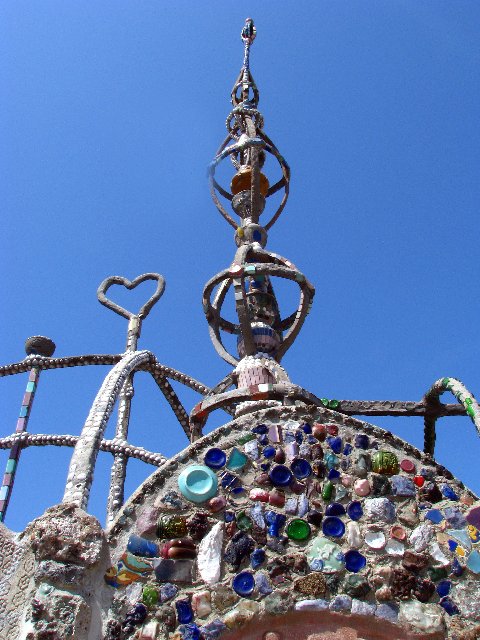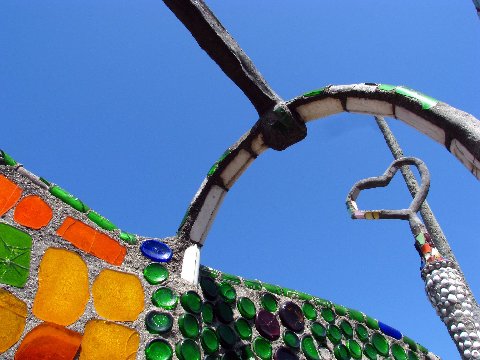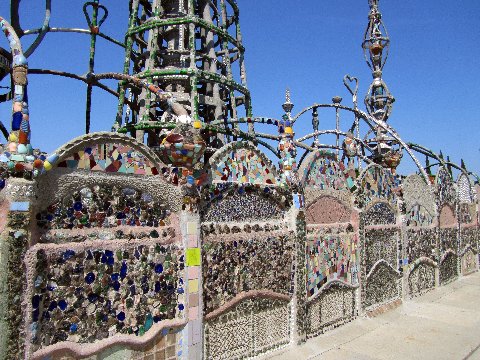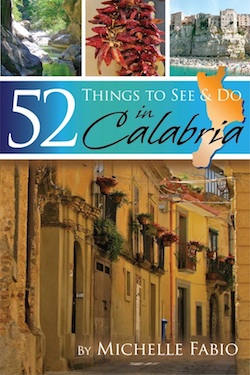Author Archive
Panino Caprese: Tomato, Mozzarella, and Basil Sandwich
One of our summer staples around here is the Caprese Salad, but sometimes you just want something you can hold in your hand . . . enter the panino caprese.
As with many Italian dishes, the quality of ingredients in this week’s What’s Cooking Wednesday is extremely important, so you should use the best tomatoes (homegrown off the vine), mozzarella (di bufala) and olive oil (extra virgin) you can find. Basil, oregano, and salt round out the ingredients.
I like to put some olive oil on each inside of the bun to start, but you can assemble this any way you like. I do sliced mozzarella first, then sliced tomatoes, then basil, oregano, and salt — with another drizzle of olive oil over the tomatoes to finish it off.
Remember, “panino” in Italy just means a sandwich — it can be on any kind of bread or roll and certainly doesn’t need to be pressed in a grill. That said, you are more than welcome to heat up your panino caprese as that’s tasty as well.
And if you want to whip up some focaccia seasoned with olive oil and oregano (even thyme, yum!) for this sandwich, you won’t be disappointed; indeed, the first time I had one of these, it was at Dean & Deluca in New York City. Love at first bite doesn’t begin to describe it.
Buon appetito!
Life, Death, and Cherries
Erma Bombeck famously wrote If Life Is a Bowl of Cherries, What Am I Doing in the Pits?
Today in my hometown, a man is being buried when he should be celebrating his 37th birthday with his two young daughters.
We were never exceptionally close, but my lasting memory of him will always be that during high school, he called me by my brother’s name with a “Little” in front of it. You see, my brother is six years older than me, so he wasn’t there in person to watch over me during those ever-so-important years; by his reminding me of my brother every time we passed in the hall, though, I always got the feeling he was an appointed, surrogate big brother. He was a sweetheart.
I haven’t seen him in probably 15 years or so, but my heart breaks for his family. His father was a favorite teacher of mine, I cheered and graduated with his sister, and his brother also graduated with us. And his daughters, oh those little girls, one of whom goes to school with my nephew . . . just heartbreaking.
He was the kind of person who had a smile for everyone — and I mean everyone no matter what your “status” was in our small Friday Night Lights-type town. Yeah, he was a jock, but you’d never know it, and that’s a huge compliment. Just a helluva guy, plain and simple.
So today, for one community in a little corner of Pennsylvania and all its branches throughout the world, life is more pits than cherries, but here’s an amazing performance of a silly little song as we all look ahead to the future:
Rest in peace, Trock.
May your smile brighten wherever it is you are, and may your family and friends find comfort in their memories.
Love Thursday: Los Angeles’ Watts Towers by Simon Rodia, Italian Immigrant
This week’s Love Thursday comes from our trusty correspondent Salena who recently did a great 3-part series on the Watts Towers by Simon Rodia over at her place, The Daily Rant. Salena saw a special theme emerge as she was taking beautiful photos of this amazing creation, though, and she was kind enough to share with us:
Love Blooms in L.A.
I had never even heard of this magnificent structure — so imagine my surprise when I found out that the Italian immigrant who built it actually went to America to work in the coal mines of Pennsylvania. Rodia was from Ribottoli, outside of Naples, and his real first name was Sabato.
In 1921, Rodia purchased the triangular-shaped lot at 1761-1765 107th Street in Los Angeles and began to construct his masterpiece, which he called “Nuestro Pueblo” (meaning “our town”). For 34 years, Rodia worked single-handedly to build his towers without benefit of machine equipment, scaffolding, bolts, rivets, welds or drawing board designs.
Besides his own ingenuity, he used simple tools, pipe fitter pliers and a window-washer’s belt and buckle.
Construction worker by day and artist by night, Rodia adorned his towers with a diverse mosaic of broken glass, sea shells, generic pottery and tile, a rare piece of 19th-century, hand painted Canton ware and many pieces of 20th-century American ceramics.
Rodia once said, “I had it in mind to do something big and I did it.”
The tallest of his towers stands 99½ feet and contains the longest slender reinforced concrete column in the world. The monument also features a gazebo with a circular bench, three bird baths, a center column and a spire reaching a height of 38 feet. Rodia’s “ship of Marco Polo” has a spire of 28 feet, and the 140-foot long “south wall” is decorated extensively with tiles, sea shells, pottery, glass and hand-drawn designs.
Thanks so much Salena for sharing these photos and
this inspiring story about a man, a dream, love, hard work, and persistence.
Happy Love Thursday to all!
[All text in block quotes comes from the Watts Towers website.]
Win a Bag of Café Orzo: The Italian Caffeine-Free Alternative to Coffee
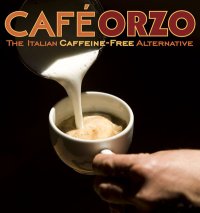 If you’ve been in a bar in Italy, you may have heard someone order “un caffè d’orzo” instead of a plain old un caffè.
If you’ve been in a bar in Italy, you may have heard someone order “un caffè d’orzo” instead of a plain old un caffè.
What is orzo?
Orzo is roasted barley, naturally caffeine-free, and DEEE-licious. I drink orzo from time to time, although I normally make it with milk into an orzo latte or orzoccino instead of drinking it like coffee — but you can certainly just put it in your coffee or espresso maker (it’s brewed the same way) and drink it “straight” like un caffè.
Where can I find orzo?
If you’re in Italy, it’s sold next to coffee in the grocery store or, of course, at the bar, but if you’re in the United States, you can now find Café Orzo in American coffee shops, cafes, and restaurants.
Café Orzo is made by two leaves and a bud, the award-winning tea company based in Colorado. They were kind enough to send me a sample when I was in the U.S., and it tasted just like what I knew in Italy. That is, YUM.
If you can’t get Café Orzo in your favorite establishment, why not tell the management about it?
What does orzo taste like?
As Café Orzo explains on its Facebook page:
It’s much richer than tea, and while we consider it an alternative to coffee, its flavor is distinctly different. Café Orzo has an earthy, nutty taste, and naturally occurring sugars in the barley impart a slight sweetness.
Couldn’t have said it better myself. I personally consider orzo a whole different drink from coffee or tea — something truly in a class all by itself.
You can also follow two leaves and a bud on Facebook, by the way.
 Where does Café Orzo come from?
Where does Café Orzo come from?
Café Orzo is 100% certified organic roasted barley that grows on small farms in Italy, near the Adriatic Sea and is artisan roasted in small batches. Yes — you’re getting the real thing from the Bel Paese.
Isn’t “orzo” a type of pasta?
Some Americans and others may know orzo as a type of small soup pasta, and indeed there is a pasta by this name, but don’t be fooled when you’re in a bar in Italy, where it’s roasted barley. In other words, if you order orzo here in a bar, you won’t get a cup of rice-like pasta, I promise.
Didn’t you mention a giveaway?
Yes!
Just comment* here with how you would enjoy your Café Orzo if you won a bag (if you’re not sure of the possibilities, check out the recipes) by 11:59 p.m. next Sunday, July 25, 2010, and you will be entered in the random drawing for a bag of Café Orzo direct from the company.
For extra chances to win, be sure to check in over at the Bleeding Espresso page on Facebook!
* Sorry for international readers, but the giveaway is limited to those with United States shipping addresses for shipping/customs reasons. If you comment below but aren’t eligible for the drawing, please specify as such (a quick “international” notation will work).
Panino Con La Mortadella Fritta
Sounds fancy, eh? OK, then let’s stick with that instead of calling this week’s What’s Cooking Wednesday what it really is: a fried bologna sandwich. With senape!
Have you ever had un panino con la mortadella fritta? Even if you don’t normally like bologna, I highly recommend finding the best sliced mortadella you can, tearing it up into smaller pieces, frying it in a pan (no oil, just a hot pan), and then slapping it on a fresh Italian roll. Oh, and add mustard.
My grandmother used to make these whenever we wanted a substantial snack but didn’t know what else to eat. P had never had one of these babies before I came along — and yes, he turned up his nose at first. But then the smell of frying mortadella got to him. He rarely has a “raw” mortadella panino now.
And even though you have to turn the stove on, frying doesn’t take very long so this ends up being a super easy summer treat around here.
Oh, and while we’re talking sandwiches/panini, be sure to check out Sara’s (Ms Adventures in Italy) explanation of the difference between a panino in Italiano and a panino in America at Panini Happy. Great stuff!
Buon appetito!

